ARCHIVED: Chapter 11. Hot In-Place Recycling (Case Histories And QC/QA)
| << Previous | Contents | Next >> |
Introduction
Hot in-place recycling (HIR) is a hot process in which the existing asphalt pavement material is recycled in place. Typically, the pavement is processed to a depth of 20 to 40 mm (¾ to 1½ in).(1) The deteriorated asphalt pavement is heated and the softened material is scarified and mixed with virgin aggregate and/or recycling agent and/or virgin asphalt mix. In the single-pass method, the restored existing pavement material is combined with virgin materials and compacted in a single pass. In the case of multiple pass hot in-place recycling, the restored and treated pavement material is recompacted in one-pass and a new overlay is applied after a prescribed interval in the next pass.
Different types of hot in-place recycling procedures have been discussed in chapter 9. The objectives of this chapter are to present selected case histories and discuss specifications and quality control/quality assurance (QC/QA) procedures required for successful hot in-place recycling. Case histories of projects using repaving and remixing processes only are available.
Case Histories
Hot In-Place Recycling in Orange County, Florida(2) (1995)
Only the construction case history is available for this project in Florida, which used the repaving process. It was decided to use hot in-place recycling process to treat cracks in the existing pavement (figure 11-1). The pavement section had a traffic count of 33,000 ADT with 10 percent trucks. First the existing surface was milled to reveal the curb (figure 11-2). The remaining surface was preheated by a preheater moving immediately in front of the single pass repaving equipment (figure 11-3). Heating was accomplished by using a forced air system. A flat flame was produced that was turned 90 degrees at combustion rather than blasting the pavement surface directly. The flame heated a ceramic wool insulation at the top of the heating hood. The insulation transferred heat to the pavement surface. The pavement surface between the preheater and the repaving equipment was generally above 107°C (225°F). The repaving unit was also equipped with a heating unit, about 5.4 m by 3.9 m (18 ft by 13 ft) (figure 11-4). Rows of air-pressured, carbide tipped scarifiers were then used to cut the heated pavement in a level plane to a depth of 25 mm (1 in) (figure 11-5). Presence of nine teeth per foot section enabled the lifting and lowering to avoid manholes and other obstacles. The scarifiers cut through the pavement and produced loose materials. The next step was the application of an emulsified recycling agent to modify the properties of the existing aged binder. In this repaving equipment, six spinning cups delivered the recycling agent to the hot scarified material (figure 11-6). The application rate was geared to the forward speed of the machine, ensuring a constant rate of application. A heavy duty carbide mold board in the repaving equipment gathered the scarified material and an auger-type conveyor distributed the material transversely across the width being processed as the recycling agent was applied. Next, the scarified material and the recycling agent were mixed. A four section, vibratory screed (figure 11-7) was used to distribute and lay the recycled material as a leveling course prior to placement of the final asphalt wearing surface. The temperature of the recycled material was 93°C (200°F) at the time of placement. Such a high temperature was felt necessary to ensure a monolithic bond between the leveling and final course. A dump truck was then used to transfer new hot mix to the repaving equipment. The mix was carried across the length of the machine via a reverse flow chain link conveyor. The vibratory screed, equipped with electronic grade and slope controls, laid the new overlay. Conventional method was then used to compact the new mix. The work was done in a single lane and traffic flow was not blocked in the other lanes (figure 11-8). The cost of recycling was estimated to be $3.44 per m2 for this project constructed in 1995.
Figure 11-1. Cracks in existing pavement.
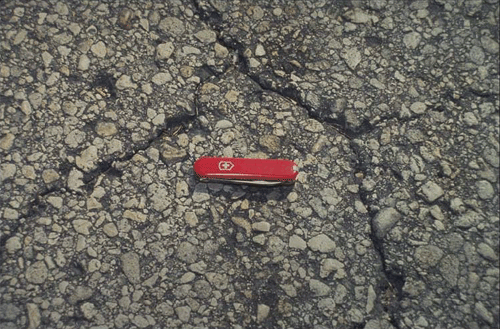
Figure 11-2. Milling.
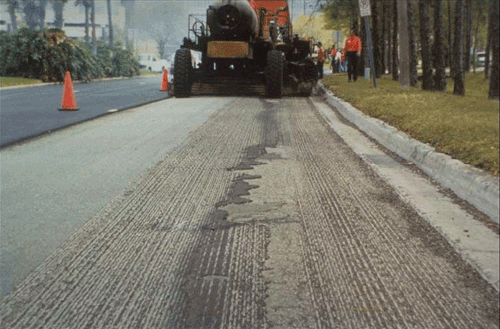
Figure 11-3. Preheater.
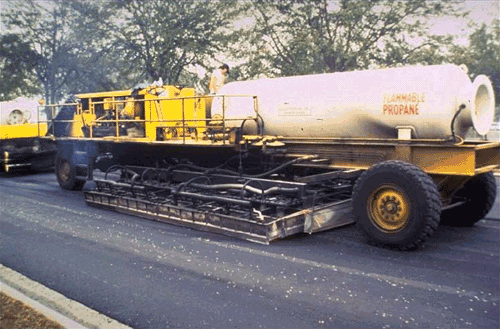
Figure 11-4. Heating unit of repaving machine.
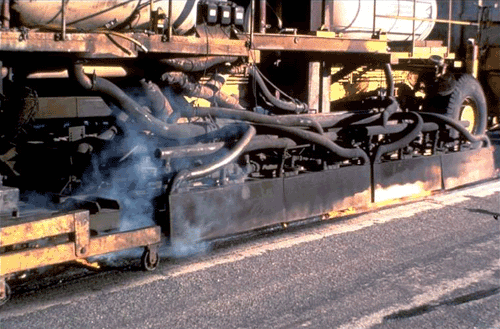
Figure 11-5. Scarifiers.
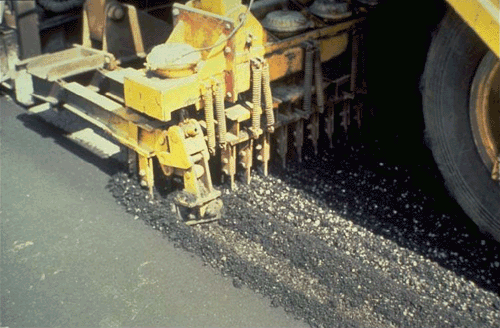
Figure 11-6. Spinning cups to spray recycling agent.
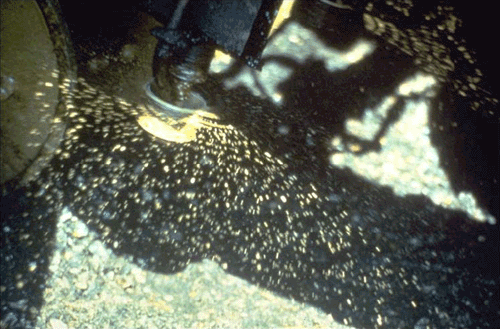
Figure 11-7. Four section vibratory screed.
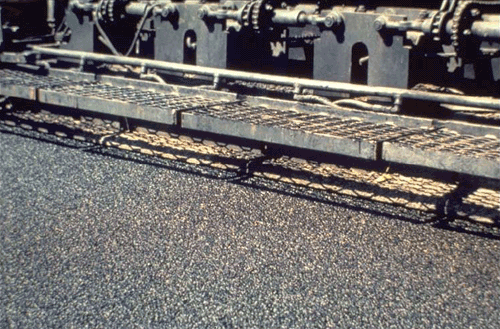
Figure 11-8. Recycling operation in one lane.
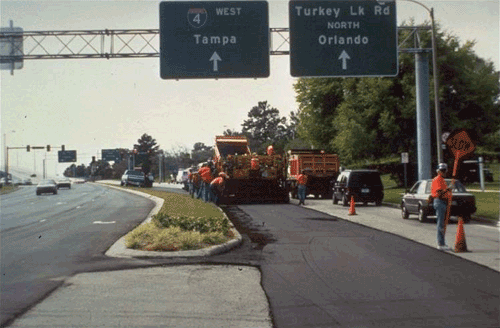
Hot In-Place Recycling Project Highway 3:14 and 3:16, Alberta, Canada(3) (1993)
This project was constructed on Highway 3:14 and :16 in May and June of 1993. The project involved the use of a hot in-place recycling equipment called "Pyropaver." Highway 3:14 and :16 is a two lane facility in the southeastern part of Alberta. The project limits were from east of Whitla to Medicine Hat. The existing pavement was last overlaid in 1975 with a subsequent seal coat application in 1977. In 1993, the average annual daily traffic (AADT) count on this highway was 3,040 with a design lane daily ESAL count of 188. Rehabilitation was required primarily due to poor ride quality caused by a relatively high incidence (50 to 70 cracks/km, 81 to 113 cracks/mile) of rough, distorted transverse cracks and minor to moderate amount of rutting (2 to 14 mm, 0.1 to 0.6 in). The existing shoulder material was extremely coarse and weathered with areas containing small cold mix patches and raveling pavement. It was decided to use hot in-place recycling to a depth of 40 mm (1.6 in), followed by a 60-mm (2.4-in) thick hot mix asphalt overlay. To obtain samples of the existing material, the project was divided into two sections. Core samples were obtained at a frequency of three cores per kilometers for a total of 18 cores in Section 1 and six cores in Section 2. Preliminary testing involved density measurement on each core and penetration and viscosity testing of the recovered asphalt binder from one lane from each site. Test results from Section 1 (in Highway 3:14) showed average asphalt content of 5.88 percent, in-place air voids of 4.9 percent and average binder penetration of 65 mm. During construction, clean fine blend sand (the gradation of the blend sand was as follows: 100, 99, 97, 70, 26.0, 9.2 percent passing the 4.75 mm, 1.18 mm, 0.60 mm, 0.30 mm, 0.15 mm, and 0.075 mm sieves, respectively) was used with the existing dense graded mix to increase the voids. No recycling agent was used since the binder was found to be borderline acceptable (penetration of 65 dmm). Section 2 (on Highway 3:16) results showed an average asphalt content of 4.55 percent, in-place air voids of 7.7 percent and average penetration of 93 dmm. Results from laboratory tests indicated that an addition of 0.3 percent (by weight of total mix) "Cyclogen L" and 10 percent blend sand was required to change the air voids to an acceptable level of 3.4 percent. The process selected for hot in-place recycling operation was a "two-stage" process. Heating of the pavement was done with both infrared heaters and open flame burners using liquid propane gas. The equipment train consisted of three units; a preheater with a simple row of 20 open flame burners, towed by a 3-ton truck, a self propelled unit containing improved heaters and milling heads, and the final unit propelled by a standard paver containing milling head. The milling heads in the second unit removed all but the center meters of the driving lane to one half of the final treatment depth. A recycling agent, when required, was pumped through two nozzles; one located near each of the two milling heads. The flow rate was positively interlocked to the speed of that unit and was monitored with an in-line flow meter. The third unit milled the center portion of the mat and picked up all of the millings from the first stage and transported them through a drag-slot conveyor over top of the final series of heaters. The second stage milling was completed by a full lane width milling head that was located at the rear of the unit.
The first stage millings were then deposited on top of the final milled windrow directly behind the milling head. A material transfer unit used a transversely mounted single shaft pugmill to mix and pick up the windrowed material for placement with the paver hopper. A removable hopper was mounted on the front of the third unit to receive an aggregate additive. The blend sand additive was fed through a gate at the back of the hopper and dropped into the first windrow prior to being picked and conveyed over the third set of heaters. A typical production rate for a full day operation was approximately 2.5 lane km. A schematic of the equipment used is shown in figure 11-9. Figure 11-10 shows the condition of the pavement before recycling, figure 11-11 shows the recycling operation, and figure 11-12 show the condition of the pavement after recycling.
Figure 11-9. Schematic of equipment used in HIR on Highway 3:14 and 3:16 in Canada.
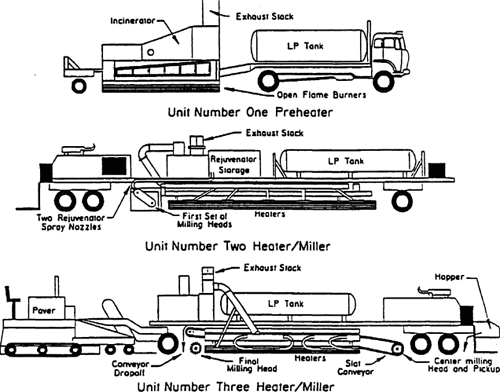
Figure 11-10. Condition of pavement before recycling.
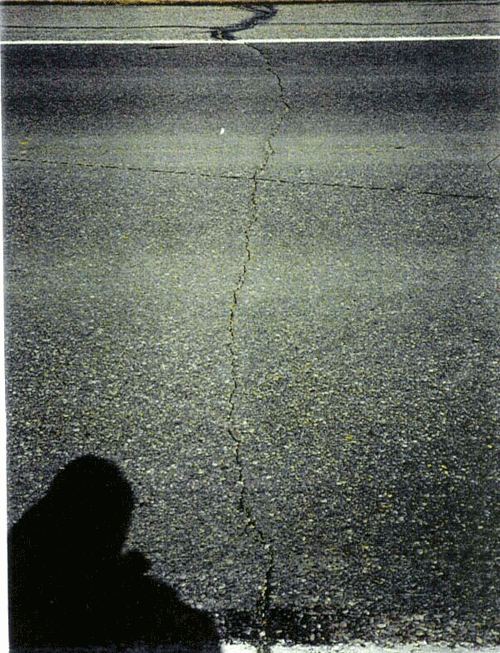
Figure 11-11. Recycling operation.
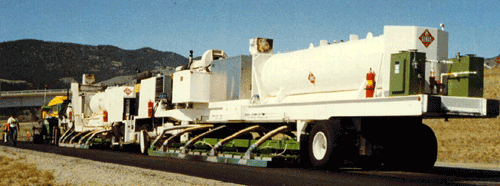
Figure 11-12. Condition of pavement after recycling.

Various nominal addition rates of "Cyclogen L" were used in the material recycled in Section 2.
Checks on the quality of Cyclogen was done by field staff monitoring an in-line flow meter. The finished hot in-place recycled surface was smooth with an average Profilograph Index of 7.3 mm/0.1 km (1.8 in/mile). The existing pavement had a Profilograph Index of 24.1 mm/0.1 km (5.9 in/mile). Emission levels varied widely throughout the project. The higher levels of emissions were generally attributed to higher production rates, stronger winds, and the presence of a seal coat treatment. For evaluation purposes, a 200-m (656-ft) part of the hot in-place recycled section was not overlaid. To date (January 1995) the surface remained in good condition, except for some spot patching on shoulders.
Material evaluation tests included density, air voids, extracted binder content and gradation. The following cost comparisons were made on the basis of equal life cycle costs:
| HIR | HMA Overlay | |
|---|---|---|
| Cost per square meter | $2.00 | $3.21 |
| Cost per Mg | $23.97 | $25.67 |
| Cost per kilometer (2-lane) | $14,600.00 | $41,400.00 |
Hot In-Place Recycling in the City of Edmonton, Canada(4) (1993)
Three sections of roadway were selected for hot in-place recycling in the City of Edmonton. These three sections included Victoria Park Road from the Goat Bridge Interchange I-115 Street, 137 Avenue eastbound from 113A Street to 97 Street and Learning Drive southbound from 167 Avenue to 144 Avenue and 50 Street to 137 Avenue. Each of the roadways had distress features consistent with surface disintegration (figure 11-13). On Learning Drive, some slight rutting was noted. Cores from each project were tested for density, asphalt content, and gradation.
Figure 11-13. Condition of pavement before recycling.
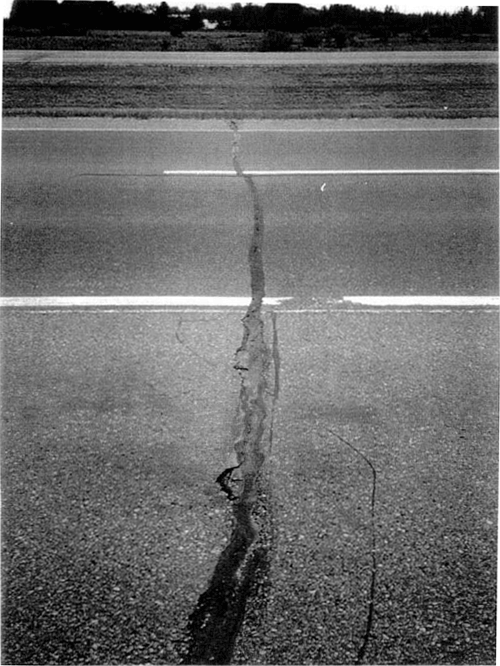
Penetration and viscosity tests on recovered asphalt binder were also conducted. Preliminary mix design consisted of the following steps:
- Cores from the project were taken and the top 50 mm (2 in) was obtained and used for mix design. In-situ density and theoretical maximum density (TMD) measurements were conducted on the top portion of the cores.
- The top portion of the cores were heated to 135°C (275°F) and then some of the material was used to compact Marshall briquettes using 75 blows per face. Marshall density, stability, and flow were measured on these compacted samples.
- Based on the information supplied by the city and design nomographs, 0.2 percent "Cyclogen L" was added to the mix to soften the aged asphalt cement.
- Four Marshall briquettes were made using the asphalt mix with "Cyclogen L" using 75 blows per face.
- The TMD was determined on the mix with "Cyclogen L" added.
- One of the four briquettes containing "Cyclogen L" was used to conduct extraction and Abson tests. Viscosity and penetration was measured on the recovered asphalt binder.
- Marshall stability and flow were measured on the other briquettes.
- After examining the air void information for the mixes, the gradation was examined and a blend sand consisting of fine concrete aggregate was added at the rate of 7 percent (for some of the projects).
- The material was reheated, mixed and compacted using 75 blows per face. Marshall properties were then measured.
The mix design results indicated several trends in the material properties. In-situ field air voids for the projects before recycling ranged from 2.1 percent to 3.2 percent. After the addition of "Cyclogen L," the void content ranged from 1.2 percent to 2.2 percent. The air voids after the addition of "Cyclogen L" was too low for two of the projects so the addition of blend sand was considered. The addition of 7 percent blend sand resulted in the voids for 137 Avenue and Victoria Park Road increasing to 2.0 to 3.2 percent, respectively. This level of air voids, although slightly lower than desirable, was considered acceptable.
The field control parameters were as follows:
- "Cyclogen L" addition rate varied from 0.15 to 0.2 percent by total weight.
- The quantity of blend sand added was kept constant at 7 percent by total weight.
- Coated blend sand was used. The amount of asphalt binder in the blend sand varied from 2.5 to 3.0 percent.
Hot in-place recycling operations began on September 19, 1993, at the west end of Victoria Park Road and proceeded east. The initial admixture settings were as follows:
- "Cyclogen" at the rate of 0.2 percent by weight of mix.
- 7 percent sand hot mix at 2.0 percent asphalt cement content.
As recycling operations progressed, the recycled mix (after the addition of 0.2 percent cyclogen) appeared quite "wet." The mix also had a slight tendency to "flush" upon completion of the compaction operations. Based on these visual observations, a decision to reduce the amount of "Cyclogen" to a 0.15 percent addition rate was implemented. The mix was continually monitored on a visual basis. After compaction on the initial stretch of the road was completed, the finished pavement surface was inspected and some "stripping" of the larger aggregate particles was evident. Some uncoated particles (crushed during milling operations) were also observed to exist as the recycled mix was fed into the paver. At this time a decision was made to increase the amount of virgin asphalt cement content in the sand mix to aid, and ensure effective coating of the aggregates. The asphalt cement content was increased incrementally to 3.0 percent. After this, the recycled mix appeared satisfactory with respect to consistency, coating, and workability - both before and after placement. These settings/addition rates were maintained for the duration of the Victoria Park Road project.
Hot in-place recycling operations on Victoria Park Road were completed on September 20, 1993 and HIR operations on 137 Avenue began on September 21, 1993, at the west end of the project on the east bound lanes. The start-up admixture ("cyclogen" and virgin sand mix) addition rates for 137 Avenue Project were kept the same as that used on the Victoria Park Road Project.
With these settings in place, the recycling mix produced appeared to be relatively "drier" than that achieved on the previous project. Therefore, the "Cyclogen" addition rate was increased to 0.2 percent. After this, the recycled mixture exhibited a satisfactory appearance and paving operation progressed without any problems.
Field construction monitoring was conducted by the City for Manning Drive. Hot in-place recycling operations on Manning Drive began September 23, 1993, at the north end of the project in the west southbound lane.
The initial admixture settings for the Manning Drive were as follows:
- Cyclogen at the rate of 0.15 percent.
- 7 percent sand hot mix at the rate of 3.0 percent asphalt cement content.
Sand hot mix for Manning Drive was supplied by the City of Edmonton Asphalt Plant to attain additional flexibility in adjusting the asphalt content and gradation of the sand mix. As the recycling operation progressed, the recycled mix appeared "wet" and test results were indicating low voids. Based on this observation and test results, the asphalt cement content in the sand mix was reduced from 3.0 percent to 2.5 percent.
On September 24, 1993, existing asphalt material conditions changed and the recycled product appeared dry. In an attempt to increase the voids in the recycled product, "Cyclogen" and/or asphalt content in the sand mix were not increased but the gradation of the sand mix was altered by reducing the amount of sand and increasing the amount of 6 mm (¼ in) material. This alteration resulted in the mixture exhibiting a satisfactory appearance.
Hot in-place recycling was attempted on September 25, 1993, but was discontinued due to low ambient temperature (7°C, 45°F) and high winds. As a result of these conditions, temperatures behind the screed of higher than 85-90°C (185-194°F) could not be attained. The 90 linear meters (295 ft) of roadway that was completed under these conditions was redone the following day. Hot in-place recycling was completed on Manning Drive on September 27, 1993.
Examination of the results of testing indicated the following:
- Aggregate gradation was relatively consistent within each project. All mixes appeared to be a 12.5 mm (½ in) top size aggregate with some variation on percent passing the 5 mm (¼ in) sieve; however, the variation was not considered extreme. The gradations for the field samples agreed very closely with the gradation considered for design.
- The asphalt content was variable on each project with the following variations noted:
Victoria Park Road 5.4 - 6.2 percent 137 Avenue 5.2 - 6.4 percent Manning Drive 5.2 - 6.0 percent - Air voids were generally low with the maximum range of 0.7 to 3.7 percent. However, the majority of the air voids fell between 1.0 and 2.5 percent.
- Stability and flow values were generally good with stability ranging from 10,936 kN (2.46 x 106 lbf) to 20,923 kN (4.70 x 106 lbf) and flow ranging from 9.1 to 13.3.
- Density of the recycled hot mix asphalt was generally higher than 97 percent of Marshall density. Because of the latent heat involved in in-place recycling, density was obtained relatively easily.
The recycling train (figure 11-14) consisted of four pieces of equipment: a preheater (figure 11-15), a heater miller (figure 11-16), a second heater miller with conveyor (figure 11-17), and a paver. The preheater was used to raise the surface temperature. The first heater miller was also used to raise the surface temperature. However, it also milled the in-place material up to a depth of 25 mm (1 in). The milled material was left as windrow in the center of the roadway. Recycling agent was added during the milling operation. The second heater miller heated up the exposed surface, milled an additional 25 mm, and also reworked the windrow of material. New mix and sand blend were added at this point. This heater miller contained a pugmill which completely reblended all milled and new material along with the recycling agent. The final unit was the paver, which was equipped with a windrow elevator. It picked up the windrow of the remixed material and laid down as a conventional paver. All equipment used to heat the pavement were equipped with environmental controls to reduce the amount of emissions. Figure 11-18 shows the condition of the road before and after recycling.
Figure 11-14. Recycling train.
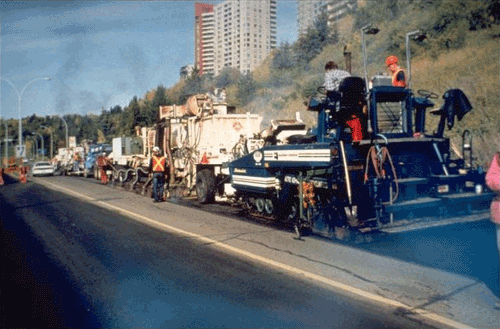
Figure 11-15. Preheater.
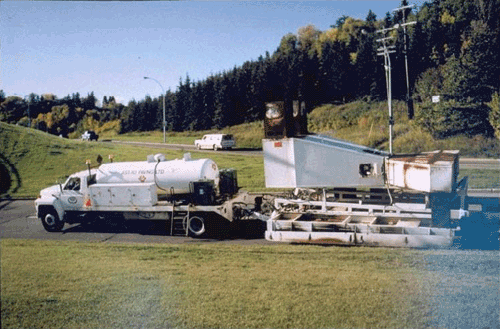
Figure 11-16. Heater miller (primary).
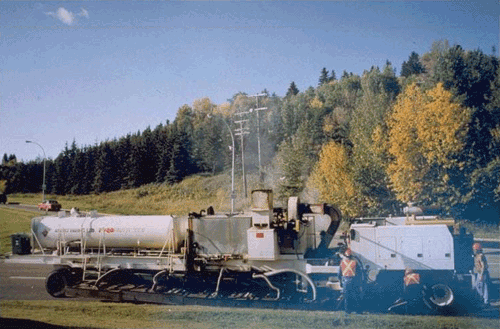
Figure 11-17. Heater miller (secondary) with paver.
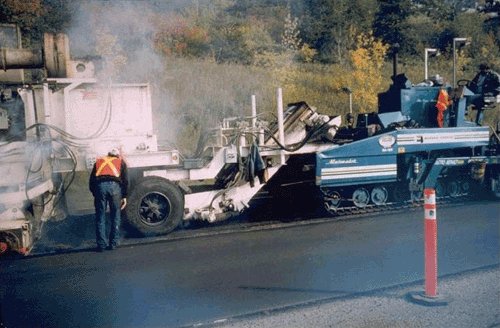
Figure 11-18. Condition before and after recycling.
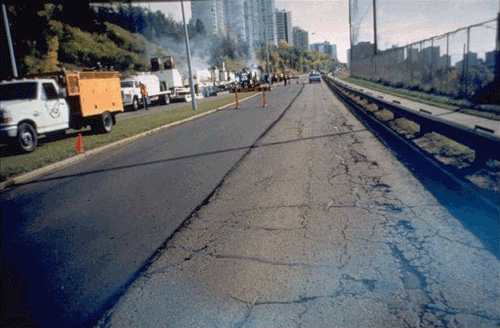
The total cost of the hot in-place recycling project was $262,701. This cost amounted to $5.01/m2 ($4.00/yd2). Compared to this, the cost of conventional remove and replacing was estimated to be $6.60 - $7.70/m2 ($5.28 - $6.16/yd2).
HIR has also been used in Canada for treating rutting at intersections. Figures 11-19 through 11-22 show recycling operations in the city of Edmonton. Figure 11-19 shows a rutted intersection. Figure 11-20 shows the recycling train. Figure 11-21 shows a closeup of the rutting intersection, and figure 11-22 shows a view of the pavement after recycling.
Figure 11-19. A rutted intersection.
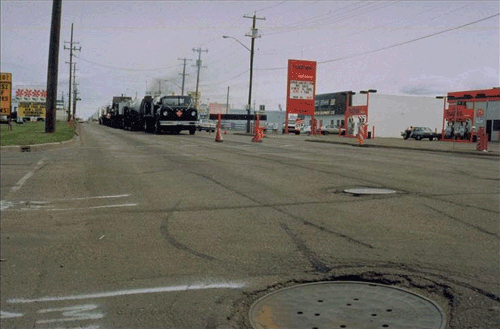
Figure 11-20. Recycling train.
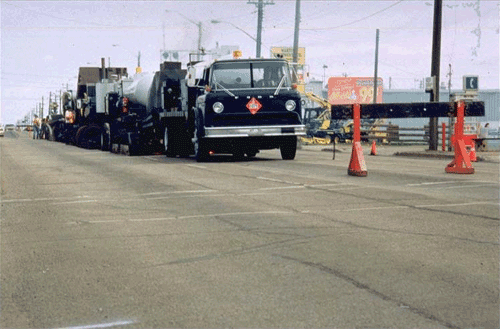
Figure 11-21. Closeup view of the rutting intersection.
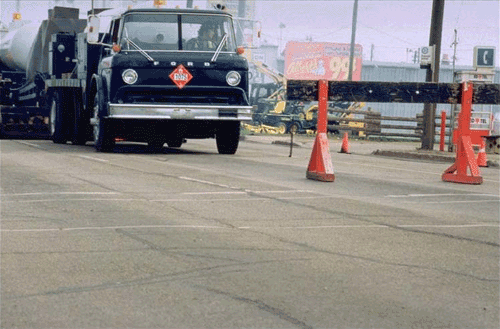
Figure 11-22. A view of the pavement after recycling.
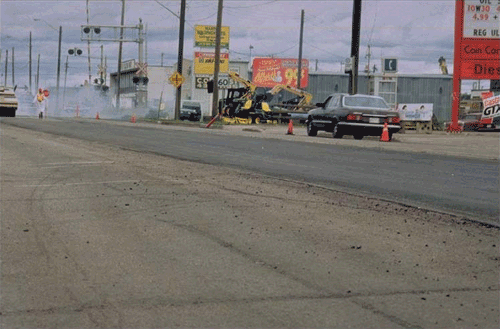
Specifications And QC/QA
Guidelines and Specifications
The two necessary steps required for ensuring satisfactory construction of a hot in-place recycling (HIR) project are the development of an adequate specification, and ensuring that the specification requirements are met during mix design and construction. As in the case of conventional asphalt overlay, a set of guidelines or specifications is required in hot in-place recycling to describe the materials, workmanship, and other general requirements for the project. Where appropriate, agencies should consider the hot in-place recycling process along with other alternatives.(5) This process can help the user agency to evaluate the two or more methods and determine the most cost effective approach.
A set of general specification guidelines for effective completion of hot in-place recycling process is presented in table 11-1.(6, modified by 5) The major steps involved are preliminary pavement evaluation to determine structural adequacy, determination of applicability of hot in-place recycling, a detailed pavement evaluation, and selection of the particular hot in-place recycling technique.
| Step | Further Details | Comments |
|---|---|---|
| 1. Preliminary Pavement Evaluation | Table 11-2 | Mainly to determine if pavement structure is adequate. |
| 2. Applicability of HIR | Table 11-2 | If HIR not applicable, develop alternative rehabilitation or reconstruction method(s). |
| 3. Detailed Pavement Evaluation | Table 11-3 | Mainly quality and properties of existing pavement surface course. |
| 4. Selection of HIR Option | Table 11-4 | Surface recycling, remix, repave or remix-repave. |
5.
| Method for determining optimum amount of recycling agent, from ASTM D 4887 | |
| 6. Completion of HIR Project | Table 11-5 | Quality control important. |
Note:
- It is assumed that the appropriate specification preparation, bidding and payment, and quality control have been incorporated in the steps, as required.
Before any rehabilitation process is specified, the most suitable rehabilitation process should be determined on the basis of the source and cause of any surface defects such as rutting, cracking and/or deficient surface frictional resistance. If the cause of the defect remains unknown, then the proper rehabilitation technique cannot be applied, and the defect would most likely reappear in future. Use of hot in-place recycling can remedy the existing problem if it is caused by mix problems, such as excess asphalt, inadequate aggregate interlock, or too hard/too soft asphalt.(5) Table 11-2 presents the information required for evaluation of the existing pavement so that a proper recycling process can be specified. The different information required include an inventory information, details about the pavement structure, knowledge of the prior treatments, geometry and profile of the pavement, and the presence of miscellaneous structures such as manholes or utility covers on the pavement. These information help the user agency to evaluate the applicability of the hot in-place recycling process, determine the need for any prior treatment (such as cold milling), and specify the particular hot in-place recycling technique applicable (such as remixing or repaving). Table 11-3(6, modified by 5) shows the importance of information from detailed evaluation of existing pavement surface. The most important surface features which must be evaluated, include cracks, wear, and rutting. The important existing HMA features include thickness, binder content, grading, density, and penetration and viscosity of the binder. Finally, the particular hot in-place recycling technique can be identified by the guidelines presented in table 11-4.(6, modified from 5) Surface recycling is employed to improve the profile of a surface course deformed by rutting or wearing, but in comparatively unaged condition with minor cracking. Repaving is used to improve the profile of a surface course severely deformed by rutting or wearing, with new hot-mix overlay placed in one pass. This method improves frictional characteristics, and provides some pavement strengthening. Remixing can be used to improve the quality of old, cracked, aged surface course by the addition of recycling agent and/or new hot mix asphalt. The existing HMA mixture should be evaluated to help specify the particular hot in-place recycling technique required and to determine the type and amount of any recycling agent required. The process basically consists of extraction and recovery of the asphalt binder from the mix, up to the scarification depth. The type and amount of recycling agent chosen should be such as to restore the binder to the as-placed rheological condition. Adjustments of amount of recycling agent may be required in the field, since laboratory evaluations often indicate more recycling agent than is actually needed.(5)
| Item | Details | Reason |
|---|---|---|
| Pavement Inventory Information |
|
|
| Pavement Structure |
|
|
| Prior Treatments (See Pavement Inventory Also) |
|
|
| Geometry and Profile |
|
|
| Miscellaneous |
|
|
Notes:
- In general, a pavement with structural defects (i.e., lack of structural capacity and/or inadequate base, beyond localized defects that can be readily repaired) will not be a suitable candidate for HIR. Pavements with non-structural surface defects (rutting, wearing, cracking, aging, poor frictional characteristics, etc.) are suitable candidates for HIR.
- Pavement width, alignment and/or gradient improvement requirements, or excessive rutting and wear (greater than about 50 mm), may preclude HIR.
| Pavement Evaluation Item | Pavement Evaluation Parameter | Surface Defect | |||
|---|---|---|---|---|---|
| Wear | Rutting | Cracking | Friction | ||
| Surface Conditiona |
| N | N | M | N |
| M | M | N | R | |
| R | R | N | N | |
| Existing Asphalt Concreteb (usually surface course, but must be at least to proposed scarification depth) |
| M | M | M | M |
| M | M | M | M | |
| M | M | M | M | |
| M | M | M | M | |
| M | M | M | M | |
| M | R | M | N | |
Notes:
- M = Mandatory
- R = Recommended
- N = Not Necessary
- Information should be representative of the pavement section involved, with special areas (extensive patching for example) and localized structural distress areas noted.
- Typically based on a coring program. Cores should be representative of pavement section involved, with additional cores taken as necessary for special areas.
| Purposea | Option | Process |
|---|---|---|
| To improve the profile of a surface course deformed by rutting or wearing, but in comparatively unaged condition with minor cracking.b | Surface recycle | Heating, Scarification, Rejuvenator (if needed), Leveling, Reprofilingc, Compactiond |
| To improve the profile of surface course severely deformed by rutting or wearing, with new hot-mix overlay placed in one pass. To improve frictional characteristics. To provide some pavement strengthening. | Repave | Heating, Scarification, Rejuvenation, Leveling, Laying New Hot Mixf, Reprofiling, Compactiond |
| To improve the quality of old, cracked aged surface course by the addition of rejuvenator and/or new hot mixe. | Remix | Heating, Scarification, Rejuvenator, Mixing and/or New Hot Mix, Mixing, Leveling, Reprofiling, Compactiond |
Notes:
- Primary purpose given in each case.
- Often used prior to hot-mix resurfacing (surface recycling).
- Standard screed and screed controls.
- Standard compaction equipment and procedures.
- The composition, grading, and/or asphalt-cement content of the new hot mix can be adjusted to improve the quality of the old mixture.
- Standard augers and auger controls.
For construction guidelines in specifications for recycling, the average recycled mixture temperature required for satisfactory compaction is in the 105°C to 115°C (221°F to 239°F) range at the breakdown rolling,(6) depending on specific site and ambient condition, and for scarification of the existing old HMA to be effective and efficient, the minimum temperature at the depth of the scarification should be the softening point for the project's recovered asphalt cement before rejuvenation.(5)
The two common types of specifications used for HMA construction are the method and the end-result specifications. The method specification describes in detail the equipment and procedures used to obtain the desired quality of asphalt mixture.This type specification requires sufficient detail to describe all the variables required to obtain a satisfactory asphalt mixture. On the other hand, an end-result specification sets the limits on certain properties of the HMA, and the method of construction is left at the discretion of the contractor. There are advantages and disadvantages for both types of specifications. For example, if a user agency has sufficient experience with the construction method, a method specifications may be easier to write. However, method specification requires that an inspector be on the job at all times to ensure proper compliance with the procedure. The end-result specification may be easier to write, since it is shorter and less detailed than the method specification. However, it may be very difficult to determine what properties to specify and what limits to set for these properties. This becomes more of a problem when dealing with material with high amount of variability, such as recycled asphalt pavement (RAP) material. Hence, in the case of recycling it is best to adopt a specification which is a combination of method and end-result specification. In this way, the experience of the user agency, contractors, material suppliers and equipment manufacturers can be utilized to obtain a recycled HMA with desirable quality.(6) Generally, the specifications for recycling projects are more of end-result nature than of method specification. This allows, and also encourages, the contractor to develop and use new construction methods and equipment for HMA recycling. However, in some cases it may be required to specify the type of equipment that will produce an acceptable pavement.(5) It is advisable to specify that the application rate of the recycling agent and any virgin HMA must be related directly to the forward movement of the equipment to minimize variation during speed changes and stoppages.(5)
Quality Control/Quality Assurance (QC/QA)
Quality control (QC) refers to those tests necessary to control a product and to determine the quality of the product being produced. These QC tests are usually performed by the contractor. Because of greater variation expected in the case of recycled HMA, the frequency of testing should be more, even though the same tests that are used in the case of conventional HMA may be used. Before starting construction, it is very important to know the quality of the existing pavement, in terms of aggregate gradation and asphalt content of the mix. The pavement should first be delineated into subprojects, on the basis of differences in design, maintenance and rehabilitation actions. Once the subprojects are identified, samples should be taken from each of the subprojects to obtain representative materials. In this way the variation in the existing material can be identified and evaluated.(7)
In general, the quality control and quality assurance (QC/QA) measures for hot in-place recycled mixes should be similar to those for the hot mix recycled mixtures. The reader is referred to chapter 8 for this. However, unlike recycled mixtures produced in a HMA plant, the hot in-place recycled mixes are produced and modified in the field. Therefore, some features involving sampling and testing of HIR mixes need to be discussed.
In hot in-place recycling, the softened material from the existing pavement is scarified and recompacted after mixing with recycling agent. Samples of in-place mix can be obtained from the laydown machine for checking the mix components such as gradation and asphalt content. The scarified existing material can also be sampled behind the scarifiers. The National Center for Asphalt Technology (NCAT) ignition oven can be used to determine the amount of asphalt binder (or recycling agent) being incorporated in the recycled mix by checking the asphalt content of the existing, scarified mix and the asphalt content of the recycled mix.
Items of interest in hot in-place recycling to be checked or observed are recycled mix temperature, compacted mat density, surface smoothness, cross slope, handwork, mat depth, and general mat appearance. Proper care should be taken to avoid excessive smoke or flames on the pavement. Some recommended guidelines for quality control are presented in table 11-5.(6, modified by 5) Some of the tests mentioned in table 11-5 can also be used for quality assurance (QA) by the user agency. However, the frequency of QA tests is usually significantly lower than the frequency of QC tests. Many of the features are same as those of conventional hot mix construction. The important features are the applicability of ASTM D 4887 for recycling application, the new mixture (if any) addition rate, the thickness of the new hot mix overlay (if any), and the temperature at breakdown rolling. Some states require construction of a test strip to evaluate the recycling process, before starting actual operations. The New York DOT remixing specification requires that the contractor sample, test, and supply test results of the recycled loose mixture.(8)
| Item | Recommended Methodb |
|---|---|
| Width | As usual |
| Depth of Scarification | Measure depth from existing surface adjacent to second mixer or Use circular ring methodc |
| Rejuvenator Application Rate (if any) | ASTM D 4887 Calculate from quantity used |
| Rejuvenator Quality (if any) | As usual (specifications and ASTM D 4552) |
| New Mixture Addition Rate (if any) | Calculate from quantity used (tons) and in-place density |
| Thickness of New Hot-Mix Overlay (if any) | Calculate from quantity used (tons) and in-place density |
| Temperature at Breakdown Rolling | Monitor at mid-point of re-profiled depth |
| Temperature of New Hot-Mix (if any) | As usual |
| Asphalt Cement Content, Gradation, and Stability Requirements | As usual |
| Compaction | As usual. Important to compare to relevant re-compacted density |
| Surface Tolerance | As usual |
| Penetration/Viscosity and Softening Point of Asphalt Extracted from Recycled Mixture | As usual |
Notes:
- As the HIR processes are largely based on conventional hot-mix paving technology, it is only necessary to supplement the usual quality control requirements. The quality control items and frequency of testing should be established at the level necessary to ensure specification compliance.
- All testing should be done on random, representative samples, by qualified technicians in a certified laboratory.
- A ring of known internal diameter (typically, 355 mm = 0.1 m2 area) is pushed into the scarified old pavement as deeply as possible, the scarified old mixture within the ring is removed and its mass determined, and from the bulk density of the old pavement the depth of scarification is calculated.
Summary
In hot in-place recycling, the existing pavement is heated and the softened material is scarified and mixed with virgin aggregate and/or recycling agent and/or virgin asphalt mix. Different types of hot in-place recycling methods can be selected, based on the type of distress in the existing pavement. The three primary types of hot in-place recycling processes are surface recycling, repaving, and remixing. Case histories for these three kinds of recycling show that hot in-place recycling can effectively treat pavement distress at a much lower cost, compared to conventional rehabilitation treatments. However, to ensure proper performance, hot in-place recycling operation must be accompanied by strict quality control and quality assurance measures. The cause of distress in the existing pavement must be ascertained and the applicability of hot in-place recycling must be evaluated. Based on the type of distress and objective of rehabilitation the proper hot in-place recycling procedure should be selected. Testing of the existing asphalt binder is required to evaluate the effectiveness of the chosen recycling agent. For construction guidelines, recommendations regarding mat temperature during rolling should be followed. In general, QC/QA measures for hot in-place recycling are similar to those for hot mix recycling. However, softened and scarified material should be evaluated for gradation and asphalt binder properties in hot in-place recycling. Items of interest to be checked include depth of scarification, recycled mix temperature, compacted mat density, surface smoothness, cross slope, handwork, mat depth, and mat appearance.
References
- An Overview of Recycling and Reclamation Methods for Asphalt Pavement Rehabilitation, Asphalt Recycling and Reclaiming Association, August, 1992.
- Information obtained from John R. Rathbun, CUTLER Repaving Inc., Lawrence, KS, 1996.
- J. Gavin and G. Lamb. 1993 Hot In-Place Recycling Project. Highway 3:14 and :16 E. of Whitla to Medicine Hat, Alberta Transportation and Utilities, January, 1995.
- EBA Engineering Consultants Ltd. The City of Edmonton Hot-In-Place Recycling, The City of Edmonton, February, 1994.
- J.W. Button, D.N. Little, and C.E. Estakhri. Hot In-Place Recycling of Asphalt Concrete, NCHRP Synthesis of Highway Practice 193, TRB, National Research Council, Washington, DC, 1994.
- J.J. Emery, J.A. Gurawka, and T. Hiramine. Asphalt Technology for In-Place Surface Recycling Using the Heat Reforming Process, Proc. of the 34th Annual Conference of Canadian Technical Asphalt Association, Vol. XXXIV, 1989.
- American Society for Testing and Materials. Annual Book of ASTM Standards, Section 4 Construction, Vol. 04.03, 1996.
- Materials Bureau. Item 19403 - Asphalt Concrete Hot In-Place Recycling Specifications, New York Department of Transportation, Albany, NY, February, 1992.
| << Previous | Contents | Next >> |

